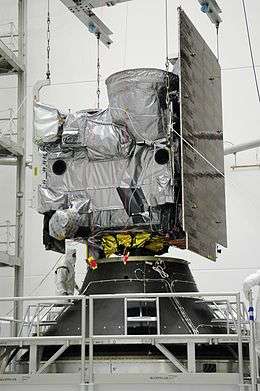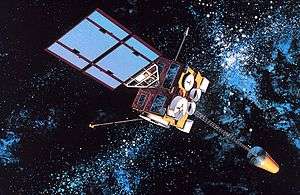GOES 13
DOD-1 (Department of Defense-1)[1] is a weather satellite of the U.S. Air Force, formerly GOES-13 (also known as GOES-N before becoming operational) and part of the National Oceanic and Atmospheric Administration's Geostationary Operational Environmental Satellite system. On April 14, 2010, GOES-13 became the operational weather satellite for GOES-East.[2] It was replaced by GOES-16 on December 18, 2017[3] and on January 8, 2018 its instruments were shut off and it began its three-week drift to an on-orbit storage location at 60° West longitude, arriving on January 31. It remained there as a backup satellite in case one of the operational GOES satellites had a problem until early July 2019, when it started to drift westward and was being transferred to the U.S. Air Force.[4][5][6] GOES-13 was renamed to DOD-1 during the transition.
 GOES-N during processing | |
| Mission type | Weather satellite |
|---|---|
| Operator | NOAA/NASA, U.S. Air Force |
| COSPAR ID | 2006-018A |
| SATCAT no. | 29155 |
| Website | goes.gsfc.nasa.gov |
| Mission duration | Planned: 10 years Elapsed: 13 years, 11 months and 6 days |
| Spacecraft properties | |
| Spacecraft type | GOES-N series |
| Bus | BSS-601 |
| Manufacturer | Boeing |
| Launch mass | 3,133 kilograms (6,907 lb) |
| Power | 2300 watts |
| Start of mission | |
| Launch date | 24 May 2006, 22:11:00 UTC |
| Rocket | Delta IV-M+(4,2) |
| Launch site | Cape Canaveral SLC-37B |
| Contractor | Boeing |
| Orbital parameters | |
| Reference system | Geocentric |
| Regime | Geostationary |
| Longitude | 61.5° East |
| Slot | Storage |
| Semi-major axis | 42,163.0 kilometres (26,198.9 mi) |
| Perigee altitude | 35,768.5 kilometres (22,225.5 mi) |
| Apogee altitude | 35,817.3 kilometres (22,255.8 mi) |
| Inclination | 0.2° |
| Period | 1,436.1 minutes |
DOD-1 arrived at 61.5 degrees east longitude in mid-February 2020.[7] NOAA will continue operating DOD-1 on behalf of the U.S. Air Force, and the satellite will become fully operational for the Indian Ocean in mid-2020.[1]
Launch
_launch_with_GOES-N.jpg)
GOES-N was launched aboard a Boeing Delta IV-M+(4,2) rocket, flying from Space Launch Complex 37B at the Cape Canaveral Air Force Station. The launch occurred at 22:11:00 UTC on May 24, 2006.[8]
The launch had been delayed significantly due to a number of issues. First, it had been scheduled to fly on a Delta III,[9] but after three consecutive failures on its first three flights, the Delta III was canceled, with GOES launches being transferred to the Delta IV. Further delays were caused after the previous Delta IV launch, the maiden flight of the Heavy configuration, suffered a partial failure.[10] Then, two launch attempts in August 2005 were scrubbed, the second attempt just four minutes and 26 seconds prior to liftoff.[11]
After these launch attempts, the rocket's flight termination system batteries expired, requiring replacement.[12] A strike by workers at Boeing subsequently pushed the launch back to May 2006.[13]
Spacecraft
At launch, the satellite had a mass of 3,133 kilograms (6,907 lb), and an expected operational lifespan of ten years, although it carries fuel for longer.[14] It was built by Boeing, based on the BSS-601 satellite bus,[15] and was the first of three GOES-N series satellites to be launched.
Operations
In December 2007, GOES-13 was called up to provide coverage of the east coast of the United States during an outage of GOES-12 due to a thruster leak. After the problem with GOES-12 cleared, it resumed operations, and GOES-13 was deactivated again. It was also briefly activated in mid-May 2009 when GOES-12 developed another thruster problem, however, it did not need to take over operations, and was deactivated by the end of the month. In April 2010, GOES-13 replaced GOES-12 as GOES-East at 75° West.[16] GOES-13 served actively as GOES-East from April 2010 to December 2017. In December 2017, GOES-16 replaced GOES-13 as GOES-East.[3] On December 14, 2017, GOES-13's direct GVAR was disabled. The GOES-13 GVAR and LRIT were relayed through GOES-14 until January 8, 2018, at which time the GOES-13 GVAR relay through GOES-14 GVAR was disabled. GOES-13 ceased transmitting data, began drifting to its storage location at 60° West on January 9, and arrived there on January 31.[17] GOES-13 remained at 60°W as a backup satellite, in case one of the operational GOES satellites malfunctioned.[4]
In January 2017, the United States Air Force started to consider taking over a spare GOES satellite for monitoring the Indian Ocean after the Meteosat-8 satellite runs out of fuel in 2020.[18] GOES-13 was brought out of storage on June 19, 2019 for a period of testing,[19] and began to drift westward since July 2.[5] In September, NOAA confirmed that GOES-13 had been transferred to the U.S. Air Force after the two-year negotiation in order to fill a gap in forecasting requirements, but NOAA will continue operating the satellite on behalf of the U.S. Air Force for its remaining life span.[6] In January 2020, the U.S. Air Force revealed that GOES-13 had been renamed to DOD-1 (Department of Defense-1) and will be fully operational for the Indian Ocean in mid-2020.[1] After the 7-month drift, DOD-1 eventually arrived at 61.5 degrees east longitude in mid-February 2020.[7]
Anomalies
In December 2006, GOES-13 observed a solar flare so intense it damaged its Solar X-ray Imager (SXI).[20]
On September 12, 2012, GOES-13 began to return images with an excessive amount of noise. The noise gradually increased to the point at which the satellite was placed in standby mode on September 24 in order to allow engineers to diagnose the problem. GOES-15 temporarily provided backup imagery for a short time, with GOES-14 being taken out of in-orbit storage and prepared to be a longer-term replacement including movement towards the 75° slot normally occupied by GOES-East.[21] GOES-13 returned to normal operations on October 18.[22][23] GOES-14 was kept in normal operations and used to monitor Hurricane Sandy in parallel with GOES-13[24] before GOES-14 returned to standby status.
On May 22, 2013, at 03:40 UTC, GOES-13 was apparently hit by a micrometeorite or orbital debris (MMOD) which caused it to lose track of the stars that it uses to maintain altitude. The satellite then went into safe mode and shut down all of its instruments. The hit was believed to occur on the solar array yoke. In the short term GOES-15 was reconfigured to cover the entire United States, but operators activated GOES-14 to take over GOES-East operations at 06:00 UTC on May 23.[25] GOES-13 was scheduled to return to operational status at 15:45 UTC on June 6, 2013[26] However that was delayed due to a Critical Weather Day and Tropical Storm Andrea.[27] It returned to full duty on June 10, 2013.
On November 20, 2015, at 09:22 UTC, the GOES-13 Sounder experienced an anomaly. GOES Engineers determined that the Filter Wheel had stopped moving (the filter wheel aligns the infrared detectors with the incoming data) so data were not scanned. All 18 infrared channels were affected; the visible channel (band 19) continued sending usable data until the instruments were shut down in 2018.[28]
References
- Werner, Debra (January 13, 2020). "Air Force turns to partners for weather forecasting support". SpaceNews. Retrieved January 14, 2020.
- "GOES-NEWS". NASA. May 9, 2009. Retrieved July 8, 2009.
- Clark, Stephen (December 20, 2017). "NOAA's GOES-16 weather satellite declared operational". Spaceflight Now. Retrieved December 27, 2017.
- "Farewell to GOES-13: The History of NOAA's Former GOES East Satellite | NOAA National Environmental Satellite, Data, and Information Service (NESDIS)". www.nesdis.noaa.gov. January 10, 2018. Archived from the original on July 17, 2018. Retrieved January 10, 2018.
- Scott Tilley (September 10, 2019). "GOES-13 Gets Drafted?". Riddles in the Sky. Retrieved December 4, 2019.
- Foust, Jeff (September 19, 2019). "NOAA weather satellite transferred to U.S. Air Force". SpaceNews. Retrieved September 21, 2019.
- "Live Real Time Satellite Tracking and Predictions: GOES 13". N2YO.com. Retrieved February 20, 2020.
- McDowell, Jonathan. "Launch Log". Jonathan's Space Page. Retrieved July 8, 2009.
- "GOES-NO/P/Q — The Next Generation" (PDF). NASA. 2001. Archived from the original (PDF) on March 20, 2009. Retrieved July 8, 2009.
- Kelly, John (May 22, 2006). "For Boeing, Next Delta 4 Rocket Launch Carries More Than a Satellite". Space.com. Retrieved July 8, 2009.
- Bergin, Chris (August 16, 2005). "Delta 4 launch scrubbed - again". NASASpaceflight.com. Retrieved July 8, 2009.
- "Mission Status Center". Delta Launch Report - GOES-N. Spaceflight Now. Retrieved July 8, 2009.
- "Boeing's Launch Schedule Hit by Impending Union Strike". Space.com. October 27, 2005. Retrieved July 8, 2009.
- Krebs, Gunter. "GOES N, O, P, Q". Gunter's Space Page. Retrieved July 8, 2009.
- Wade, Mark. "HS 601". Encyclopedia Astronautica. Archived from the original on August 2, 2009. Retrieved July 8, 2009.
- "GOES-M Status". NOAA. Retrieved July 9, 2009.
- "GOES-16 DRIFT AND TRANSITION TO OPERATIONS". Retrieved February 13, 2018.
- Foust, Jeff (January 25, 2017). "Air Force considering taking over NOAA weather satellite". SpaceNews. Retrieved January 15, 2020.
- Bachmeier, Scott (June 26, 2019). "GOES-13 brought out of storage". CIMSS. Retrieved January 15, 2020.
- "A Super Solar Flare - NASA Science". nasa.gov.
- "Using polar-orbiting satellite data to help fill in gaps during a GOES-13 outage". University of Wisconsin-Madison.
- Back from the dead: GOES-13 satellite returns to active duty, Washington Post.
- "GOES-13 spacecraft status". NOAA Office of Satellite Operations. Archived from the original on January 13, 2011.
- "Hurricane Sandy Life Cycle from GOES-13 and GOES-14". University of Wisconsin-Madison.
- https://web.archive.org/web/20130607192921/http://www.ssd.noaa.gov/PS/SATS/MESS/MSG1422048.01.txt
- Update#21
- http://www.ssd.noaa.gov/PS/SATS/MESS/MSG1571428.01.txt
- Lindstrom, Scott. "GOES-13 Sounder Anomalies". Retrieved December 27, 2017.
